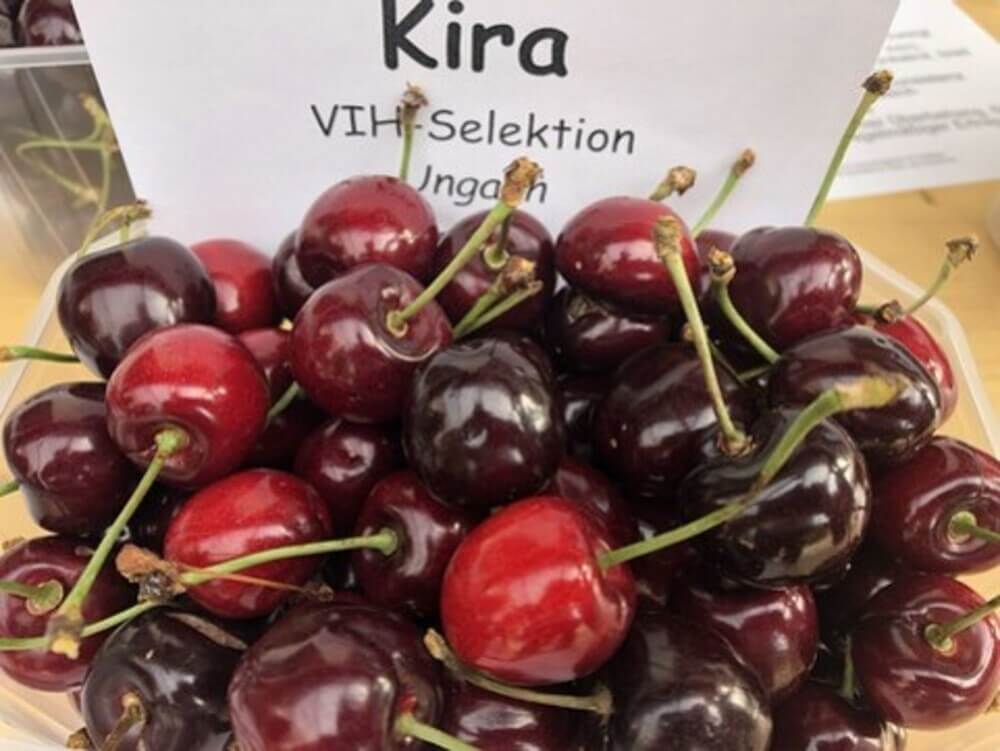Cherry breeding in Hungary dates to the 1950’s when the Horticultural Research Institute has been established. Since then many cultivars have been developed, some of them are well known worldwide among cherry breeders and growers.
In sweet cherry breeding many aims fit to the requirement of fresh market. Large fruit size (min 30 mm), fruit firmness, dark wine red shiny skin are preferred that is not prone to cracking. Regular yield, precocity is important. Hungarian consumers prefer balanced sweet-acidic taste.
Other aims are related to phenological characters such as ripening and flowering time. In recent years late spring frosts became frequent and yield loss occur, therefore we focus on selecting late blooming types. Regarding ripening time we try to extend the harvesting season having extremely early and late cultivars. Our earliest commercial Hungarian bred cultivar is ʿRitaʾ that ripens ten days before ʿBurlatʾ.
We do traditional hand pollination and make artificial crosses using commercial cultivars that fit to the above-mentioned aims. Preferred cultivars for crosses are ʿKrupnoplodnayaʾ, ʿCarmenʾ, ʿReginaʾ, ʿKordiaʾ that we combine with relatively new releases (e.g. ʿEarliseʾ, ʿBelliseʾ, ʿSatinʾ).

The crosses are performed in outdoor orchards. After harvesting the seeds they go for stratification and are sown under greenhouse conditions during winter. Some seeds from early ripening maternal parents go to embryo culture. When the seedlings are strong enough, they are planted into our hybrid orchard on their own roots.
After negative selection we evaluate them for at least for three years. In the meanwhile the best hybrids are grafted on different rootstocks and get into our orchard where final selection takes place.
The other source of breeding is the genebank collection that shows high variability in many traits. Our latest releases are ʿPapillon®ʾ, a bicolor cherry that tastes sweet, ripens 3 weeks after ʿBurlatʾ and ʿKira®ʾ, an early-mid-season large, shiny, firm cherry, both are distributed by Artevos who supports our breeding program.
 Image 2: Papillon® variety.
Image 2: Papillon® variety.
Beside breeding we have a young experimental orchard where different rootstocks (MaxMa 14, WeiGi 2, Gisela 6, PIKU 1) and canopy structures (spindle, UFO, Y) are compared and tested.
Hungary is situated in the secondary gene centre of sour cherries, therefore this diverse plant material is perfect for selecting valuable sources for breeding. This advantageous potential resulted in selecting landraces that are still among the leading commercial cultivars in Hungary and well known worldwide (e.g. ʿÚjfehértói fürtösʾ).
 Image 3: Kira® variety.
Image 3: Kira® variety.
Another way of developing cultivars is cross breeding. The breeding aims are focused on fresh market as well as industrial demands. Beside fruit quality the target is having cultivars resistant to biotic factors, such as Monilia and leaf spot (Blumeriella jaapii). For this reason, a resistant selection ʿCsengődiʾ was used in our breeding program and resulted in advanced tolerant hybrids (e.g. ʿÉrdi ipariʾ).
Validation of different molecular markers is performed in order to utilise them in our breeding program and so speeding up the breeding process. We focus on involving markers associated with fruit size, fruit skin colour and flowering time. According to our results we found some promising markers that might be involved in pre-selection of seedlings.
Zsuzsanna Békefi
Hungarian University of Agriculture and Life Sciences, Institute of Horticulture, Fruit Research Centre (HUN)
Cherry Times - All rights reserved















